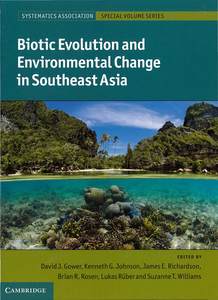The Malesian floristic interchange: plant migration patterns across Wallace's Line
Richardson, James E., Costion, Craig, and Muellner, Alexandra N. (2012) The Malesian floristic interchange: plant migration patterns across Wallace's Line. In: Gower, David J., Johnson, Kenneth G., Richardson, James E., Rosen, Brian R., Rüber, Lukas, and Williams, Suzanne T., (eds.) Biotic Evolution and Environmental Change in Southeast Asia. The Systematics Association Special Volume Series, 82 . Cambridge University Press, New York, USA, pp. 138-163.
![[img]](https://researchonline.jcu.edu.au/23672/1.hassmallThumbnailVersion/23672_Richardson_et_al_2012_Cover.jpg)
|
Image (JPEG) (Book Cover)
- Cover Image
Download (495kB) |
|
|
PDF (Published Version)
- Published Version
Restricted to Repository staff only |
Abstract
[Extract] The convergence of formerly disconnected land masses presents opportunities for plant and animal dispersal and their possible subsequent diversification in new terrain. Examples include the closure of the Isthmus of Panama in the Pliocene, the collision of India with continental Asia and the convergence of the Australian and Eurasian Plates. Perhaps the most widely discussed example of biotic migration is that of the Great American Interchange between the Laurasian North American Plate and the Gondwanan South American Plate that was the subject of George Gaylord Simpson's 'Splendid Isolation' (1980) that focused on migration patterns of animals. Prior to the development of phylogenetic methods, the primary mode of interpreting patterns in migration relied on analysis of fossil and extant distributions. Molecular phylogenetic methods that incorporate the dimension of time are a relatively new and powerful tool in the study of biogeographic history. In an analysis of plant and animal dated phylogenies of taxa that are distributed across the Isthmus of Panama, Cody et al. (2010) demonstrated that plants have a greater capacity for dispersal than animals because they had been dispersing between these areas since the Eocene whereas animals only began to disperse in the mid Miocene. Interestingly, this study indicated that many animals also had the capacity for over-water dispersal prior to closure of the Isthmus of Panama but in general they were more reliant on the formation of a direct land connection. One difference between the Panamanian and Indian convergences and that between the Australian and Eurasian Plates is that the former two both culminated in the formation of a direct land bridge, but the latter has not. Wallace (l869) noted the strong faunistic divide around the area of convergence between Australian and Eurasian Plates that would come to be known as 'Wallace's Line', Wallace was less forthcoming when describing floristic differences and determination of the significance of Wallace's Line for plants has proven far more complex than for the fauna. Any study of biotic interchange between the Eurasian and Australian Plates will ultimately enable better assessment of the capability of over water dispersal of different groups of organisms.
| Item ID: | 23672 |
|---|---|
| Item Type: | Book Chapter (Research - B1) |
| ISBN: | 978-1-107-00130-5 |
| Date Deposited: | 30 Nov 2012 05:39 |
| FoR Codes: | 06 BIOLOGICAL SCIENCES > 0603 Evolutionary Biology > 060302 Biogeography and Phylogeography @ 34% 06 BIOLOGICAL SCIENCES > 0603 Evolutionary Biology > 060310 Plant Systematics and Taxonomy @ 33% 06 BIOLOGICAL SCIENCES > 0607 Plant Biology > 060799 Plant Biology not elsewhere classified @ 33% |
| SEO Codes: | 97 EXPANDING KNOWLEDGE > 970106 Expanding Knowledge in the Biological Sciences @ 34% 96 ENVIRONMENT > 9608 Flora, Fauna and Biodiversity > 960805 Flora, Fauna and Biodiversity at Regional or Larger Scales @ 33% 96 ENVIRONMENT > 9699 Other Environment > 969999 Environment not elsewhere classified @ 33% |
| Downloads: |
Total: 616 Last 12 Months: 3 |
| More Statistics |



